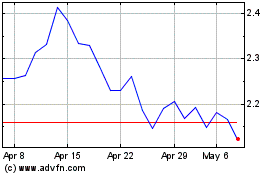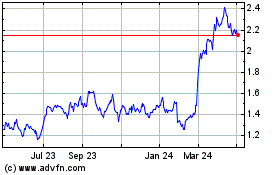LONDON—Some of the world's largest oil companies reported
sharply lower earnings on Thursday as they gave up on some ventures
that no longer make sense in a world of crude prices around $50 a
barrel.
Royal Dutch Shell PLC posted a $6.1 billion loss in the third
quarter after its decision to walk away from exploring the Arctic
for oil and exploiting Canada's oil sands resulted in $7.9 billion
in charges. Petro China Co., the biggest oil-and-gas producer by
volume in China, said its third-quarter net profit fell by more
than 80%.
Total SA, the French oil giant, said its net profit fell 69%
compared with last year's third quarter, partly the result of a
$650 million write-down in its Canada oil-sands ventures. Italy's
Eni SpA experienced a loss of â,¬952 million in the third quarter
and decided to sell 12.5% of its troubled oil-field services
company Saipem SpA.
And in the U.S., ConocoPhillips reported a loss of $1.1 billion
and announced new plans to trim spending.
This unpleasant picture is presented after a third quarter in
which Brent crude, the international benchmark for oil prices,
traded at about $50 a barrel on average, the lowest sustained
levels since the financial crisis. The companies said they were
straining to change how they do business as prices are depressed by
new supplies of U.S., Russian and Middle Eastern oil outstripping
global demand.
"The reality of the day is that we don't know when and how this
will balance out. We don't even know if it really stabilizes,"
Shell Chief Executive Ben van Beurden said on a call with reporters
Thursday. "If you have a high degree of uncertainty over the oil
price, you have to have projects that are very resilient."
Shell's about-face is among the industry's starkest. The
U.K.-Dutch giant had gained a reputation as being optimistic about
the future direction of oil prices, moving aggressively to buy BG
Group PLC for $70 billion in an acquisition seen as bullish.
Now, Shell says it is looking at $55 a barrel as the break-even
oil price for new projects and took billions of dollars in
impairment charges in the third quarter after lowering its
long-term oil and gas price outlook.
The company has moved to focus on what Mr. van Beurden sees as
its two core strengths: challenging deep water projects and
liquefied natural gas. The chief executive proved he was willing to
abandon two major developments—the Alaskan Arctic and its Canadian
oil-sands project called Carmon Creek—that he didn't see as core,
even though the company had spent billions on them.
The cost of those decisions was steep, though. And even
stripping out its impairments and write-offs, Shell reported an
adjusted profit of $1.8 billion, down 70% compared with a year
earlier and missing analysts' expectations.
Low oil prices were most apparent in Shell's upstream business,
which focuses on finding and producing oil and gas. The segment
reported a net loss of $8.6 billion in the third quarter compared
with a $3.9 billion profit a year earlier. Reduced costs and a 3%
increase in production volumes weren't enough to offset the impact
of weaker prices, the company's sizable write downs and a higher
tax bill.
The extent of the oil prices' effect on the industry will come
into sharper focus on Friday when American giants like ExxonMobil
Corp. and Chevron Corp. reveal their third-quarter earnings. Their
profits have fallen in the past year, though neither has posted a
net loss like Shell and other European companies this year.
Eni's sale of a Saipem stake to an Italian state-run investment
fund will bring in some needed cash—about €5.4 million euros—as the
company confronts low-oil prices. Eni has said that it will use the
proceeds for its exploration and production business and to shore
up its balance sheet.
Eni Chief Executive Claudio Descalzi has indicated that the 31%
stake his company still owns in Saipem could be lowered further
though he is in no rush to do so in light of the company's
depressed stock. The shares have lost half their value in the past
two years as Saipem issued multiple profit warnings and cycled
through three CEOs.
Total was able to soften the blow of low oil prices by raising
output to an average of 2.34 million barrels of oil equivalent a
day, up from 2.12 million barrels a day in the same period a year
ago. Its adjusted net profit—a closely watched figure that strips
out one-time charges such as write-downs—fell just 22% to $2.76
million, beating expectations.
Some analysts said that they weren't worried about the
third-quarter earnings. With the exception of Eni, the companies
appear committed to paying hefty dividends, and many of the losses
are "one offs," said Oswald Clint, an energy analyst at Sanford C.
Bernstein Research.
"In the nine months year to date, many are delivering cash flows
above expectations and balance sheets in the same state of health
as this time last year, and therefore the dividend payment
potential remains intact," he added.
Brian Spegele contributed to this article.
Write to Sarah Kent at sarah.kent@wsj.com, Eric Sylvers at
eric.sylvers@wsj.com and Inti Landauro at inti.landauro@wsj.com
Access Investor Kit for "BG Group Plc"
Visit
http://www.companyspotlight.com/partner?cp_code=P479&isin=GB0008762899
Access Investor Kit for "Royal Dutch Shell PLC"
Visit
http://www.companyspotlight.com/partner?cp_code=P479&isin=GB00B03MLX29
Access Investor Kit for "Royal Dutch Shell PLC"
Visit
http://www.companyspotlight.com/partner?cp_code=P479&isin=GB00B03MM408
Access Investor Kit for "BG Group Plc"
Visit
http://www.companyspotlight.com/partner?cp_code=P479&isin=US0554342032
Access Investor Kit for "EXXON MOBIL CORP"
Visit
http://www.companyspotlight.com/partner?cp_code=P479&isin=US30231G1022
Access Investor Kit for "Royal Dutch Shell PLC"
Visit
http://www.companyspotlight.com/partner?cp_code=P479&isin=US7802591070
Access Investor Kit for "Royal Dutch Shell PLC"
Visit
http://www.companyspotlight.com/partner?cp_code=P479&isin=US7802592060
Subscribe to WSJ: http://online.wsj.com?mod=djnwires
(END) Dow Jones Newswires
October 29, 2015 12:55 ET (16:55 GMT)
Copyright (c) 2015 Dow Jones & Company, Inc.
Saipem (BIT:SPM)
Historical Stock Chart
From Dec 2024 to Jan 2025

Saipem (BIT:SPM)
Historical Stock Chart
From Jan 2024 to Jan 2025
